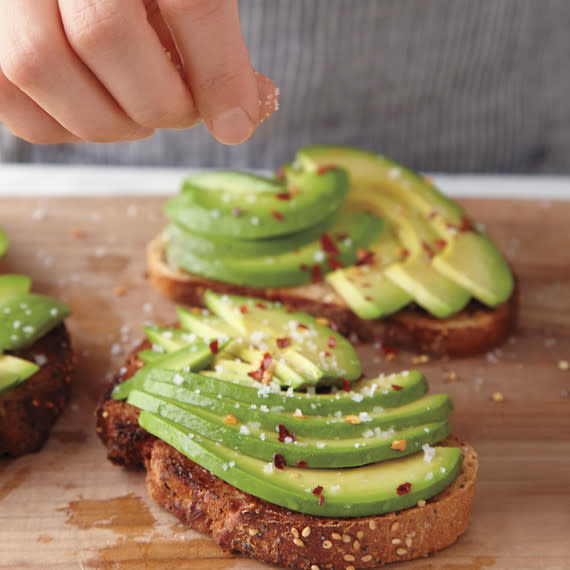What's the Difference Between Bruschetta, Crostini, Tartine, and Toast?

Avocado toast is everywhere—we liken it to the tomato bruschetta of recent years. And like bruschetta, which we Americans seemed to discover all at once at some point in the '90s, avocado toast became an instant classic, almost a cliché. At this point we might even take it for granted, yet nothing can match its perfection: good, rustic bread with luscious avocado and a sprinkling of crunchy sea salt on top hits all the spots. Drizzle it with olive or coconut oil, take your pick.
It seems that every toast may have its day, and while bruschetta, crostini, tartine, and toast seem similar, each has a few distinguishing characteristics, Ready to learn about your favorite slice of bread? Here, we explain the differences.
Related: 12 Bakery-Worthy Breads You Can Make at Home
Bruschetta or Crostini?
Both are Italian words but you may notice that bruschetta is singular and crostini is plural, that's a clue to the way in which they are traditionally served. Bread should be grilled or broiled to some degree of char to be called bruschetta, and it's always heavenly. Whether it's soaking up juicy, chopped tomatoes and olive oil, or simply rubbed with a halved garlic clove, there is truly nothing better. Crostini are generally made with white bread, such as a simple Italian loaf or a baguette, sliced evenly, and toasted just to crisp it up, not to darken it unduly. In Italian crostina means crusty, and crostini means toasts.
Even though there are clear Italian definitions, that there are exceptions seems unavoidable. There is some name confusion, for example, when cherries and soft cheese are served on top of toasted bread, is it a crostini or a bruschetta? Whatever you call it, it's delicious.
Toast (See Crostini, Above)
Slices of bread, toasted until golden brown and to varying degrees of crispness, that's toast. This can be done in a toaster, under the broiler, or by putting the slice of bread on a toasting fork and holding it over the fire. The word is really a catchall, and when you use it no one is going to tell you what type of bread to use or whether your toast must be cut into perfect squares or hefty, peasant slabs. But thin, golden triangles with the crusts taken off can only be known as toast points.
If you want to talk about the specs for Melba toasts, which are more like fancy crackers, that's another thing entirely. The story goes that Melba toast was created by the famed French chef Auguste Escoffier in the late 19th century and named after Australian opera singer Dame Nellie Melba. Popularized in America in the 1920s as part of a low calorie diet, they have since been mostly associated with retro cocktail party fare. The store-bought Melba toasts have been shaved on a mechanical slicer, but if you slice white bread as thinly as you can and toast until golden and very crisp, that'll do. Melba toast is the perfect base for delicate creamy spreads and seafood patés. Of course, toast is just the starting point. It's a canvas for all manner of toppings like cream cheese and peanut butter (or nut-free riffs on PB).
When Is a Sandwich a Tartine?
Just when it seems like we're getting somewhere in terms of sorting this all out, we encounter the tartine. Basically it's a French word for an open-faced sandwich. Tartines can be small or large, eaten for breakfast or lunch. Tartines might be made with thinly sliced, dense bread and arranged in pretty, Scandinavian Smorrebrod fashion (as is served at the Belgian chain of bakeries and cafes, Le Pain Quotidien), or in an idealized rustic style, such as a delicious version served at NYC's beloved Francophile boîte, Buvette Gastrothèque. Their version of a tartine adapts Italian ingredients to a French sensibility for a delicious, indulgent appetizer, thereby adapting the language too.
The truth is that toast is a blank slate for countless toppings and creative spins, and in most cases the title it's given it is up to the cook. Because really, at the end of the day, it's all bread anyway isn't it?
